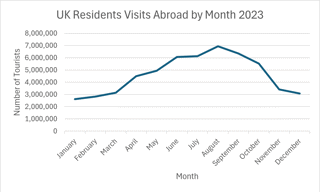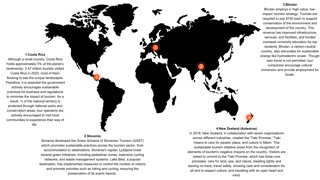Introduction
As the weather in the UK finally warms, with evenings at their longest and the school summer holidays on the horizon, many of our thoughts turn to that long-awaited summer break. Whether it's an all-inclusive resort, camping in the countryside, action-packed activities, or just relaxing by the pool with a good book, the summer break tends to be the big holiday of the year. Therefore, it is no surprise that July and August are the most popular months for UK residents to go on holiday.

Figure 1: UK residents visit abroad in 2023. Adapted from ONS
There has, however, been growing concern from locals and internationals alike over the sustainability of tourism in many places. It is important to remember that sustainability is not purely about environmental considerations; it should also take into account the impacts on people, communities and the economy.
In some places, tourism is the main source of income and local communities have become dependent on that income. The COVID-19 pandemic highlighted the risks of relying on this single income source. For example, the islands of Antigua and Barbuda in the Caribbean, 91% of total employment in 2019 was tourism, accounting for nearly 34,000 jobs. With limited to no tourism in the first half of 2020, the impact was felt with a 20.7% decline in active employment. Additionally, tourism can lead to the destruction of natural landscapes and increased pollution.
According to Statista.com, tourism is expected to contribute $11.1 trillion to global GDP, an increase of $1.2 trillion from 2023, and $0.8 trillion from 2019. Therefore, balancing environmental, economic, and social sustainability is crucial for the future of tourism. This edition of Geography in the News reflects the articles in the news over the past few years that explore different perspectives of sustainable tourism.
What’s wrong with the current tourist model?
Many of the early formats of 1980s ‘package holidays’ have endured, resulting in the same tourist model persisting forty years later. While this may evoke nostalgia and familiarity, it has significantly impacted local populations who largely miss out on tourism's benefits. In addition, the environmental effect on these areas can be significant, resulting in land degradation, limited water supply and biodiversity loss.
In April 2024, thousands of people in the Canary Islands, along with residents of Madrid and Barcelona, protested about the negative impact of tourism on the Islands. In 2023, nearly 14 million tourists visited the Canary Islands alone, contributing to 35% of their collective GDP. However, prolonged tourism has had significant consequences, with an estimated 33.8% of the population at risk of poverty and social exclusion. The protests aimed to highlight the inequality in the tourism industry and the ecological damage caused by increased development. The goal was to advocate for a new model that safeguards both people and the environment.


Sustainable tourism stories (from the image above)
1. Costa Rica
Although a small country, Costa Rica holds approximately 5% of the planet’s biodiversity. 2.47 million tourists visited Costa Rica in 2023, most of them flocking to see the unique landscapes. Therefore, it is essential the government actively encourages sustainable practices for business and regulations to minimise the impact of tourism. As a result, ¼ of the national territory is protected through national parks and conservation areas, tour operators are actively encouraged to visit local communities to experience their way of life.
2. Slovenia
Slovenia developed the Green Scheme of Slovenian Tourism (GSST) which promotes sustainable practices across the tourism sector, from accommodation to destinations. Slovenia's capital, Ljubljana hosts several green initiatives, including pedestrian zones, extensive cycling networks, and waste management systems. Lake Bled, a popular destination, has implemented measures to control the number of visitors and promote activities such as hiking and cycling, ensuring the preservation of its scenic beauty.
3. Bhutan
Bhutan employs a ‘highvalue, low-impact’ tourism strategy. Tourists are required to pay $100 each to support conservation of the environment and development of the country. This revenue has improved infrastructure, services, and facilities, and funded overseas university education for top students. Bhutan, a carbon-neutral country, also advocates for sustainable energy like hydroelectric power. Though solo travel is not permitted, tour companies encourage cultural immersion and provide employment for locals.
4. New Zealand (Aotearoa)
In 2018, New Zealand, in collaboration with seven organisations across different industries, created the 'Tiaki Promise.' Tiaki means to care for people, place, and culture in Māori. This sustainable tourism initiative arose from the recognition of elements of tourism's negative impacts on the country. Visitors are asked to commit to the Tiaki Promise, which has three core principles: care for land, sea, and nature, treading lightly and leaving no trace; travel safely, showing care and consideration for all and to respect culture; and travelling with an open heart and mind.
Conclusion
While the allure of a cheap getaway is strong, especially during times where finances are stretched, it's crucial to remember that, as guardians of the planet, we must adopt practices that promote a sustainable future for everyone. By supporting local communities, respecting the environment and using travel options which produce less carbon emissions, we can make sure that the wonders of the planet we want to explore now are still there for future generations.
Further reading
